A correspondent submitted the following image, captured Thursday in New York:

Random rants and ruminations

 Tumbleweed Houses: the antithesis of McMansions. And the perfect place to park your Mini Cooper.
Tumbleweed Houses: the antithesis of McMansions. And the perfect place to park your Mini Cooper.
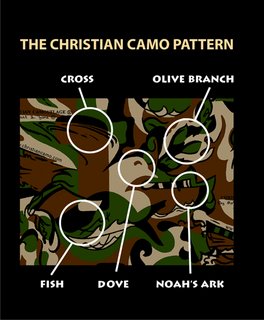 I'd always pictured Him in a simple robe, but that can get a little drafty when you're out in the woods hunting God's creatures. Hence this.
I'd always pictured Him in a simple robe, but that can get a little drafty when you're out in the woods hunting God's creatures. Hence this.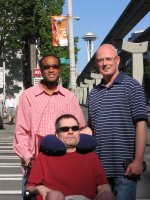 It must have been Opposite Day, because it was cold and rainy in D.C. and warm and sunny in Seattle. That city is one of the few places I’ve never heard a negative comment about, and I liked it as much as I’d expected. We stayed downtown and did a bit of wandering, but I wish we’d had more time.
It must have been Opposite Day, because it was cold and rainy in D.C. and warm and sunny in Seattle. That city is one of the few places I’ve never heard a negative comment about, and I liked it as much as I’d expected. We stayed downtown and did a bit of wandering, but I wish we’d had more time.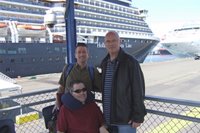
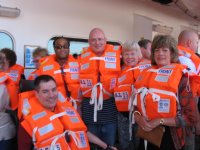 Almost as large as the ship were some of the passengers. Anyone who doubts America’s weight problem should go on a cruise. Lots of oldsters and crips, too, because this is as accessible as vacations get. You just roll around, having fun and enjoying the ever-changing scenery as you sail from one place to another. I’d worried about leaving Ingmar, my beloved power wheelchair, at home, but the Seattle chapter of the ALS Association was kind enough to lend me one, which was waiting in our stateroom when we boarded. It was even decorated for the occasion.
Almost as large as the ship were some of the passengers. Anyone who doubts America’s weight problem should go on a cruise. Lots of oldsters and crips, too, because this is as accessible as vacations get. You just roll around, having fun and enjoying the ever-changing scenery as you sail from one place to another. I’d worried about leaving Ingmar, my beloved power wheelchair, at home, but the Seattle chapter of the ALS Association was kind enough to lend me one, which was waiting in our stateroom when we boarded. It was even decorated for the occasion.



 Dody was Indonesian, like most of the 800 crew members -- the most cheerful and efficient staff I’ve ever encountered. We wanted desperately to bring him home with us; he’s exactly what I need. (Had we done so, though, we’d have had to tell him that he was confusing “Mr. Dan” with “Mr. Jack.”)
Dody was Indonesian, like most of the 800 crew members -- the most cheerful and efficient staff I’ve ever encountered. We wanted desperately to bring him home with us; he’s exactly what I need. (Had we done so, though, we’d have had to tell him that he was confusing “Mr. Dan” with “Mr. Jack.”) Some of our fellow passengers were a little strange, like the woman who approached us at lunch one day. Ignoring me completely, she asked Dan how I ended up in a wheelchair. She then told us that she’d been awakened in the middle of the night by a phone call informing her that her son had been in a motorcycle accident and would be a vegetable in the unlikely event that he survived at all. It seemed odd that she would share such details with strangers, but I figured she was raw with shock and grief. Until the next morning, when I heard her mention to a steward (rather breezily, I thought) that most of her son’s face had been scraped off in the accident.
Some of our fellow passengers were a little strange, like the woman who approached us at lunch one day. Ignoring me completely, she asked Dan how I ended up in a wheelchair. She then told us that she’d been awakened in the middle of the night by a phone call informing her that her son had been in a motorcycle accident and would be a vegetable in the unlikely event that he survived at all. It seemed odd that she would share such details with strangers, but I figured she was raw with shock and grief. Until the next morning, when I heard her mention to a steward (rather breezily, I thought) that most of her son’s face had been scraped off in the accident.
Nobody caught a virus, thank God -- not that I’m aware of, anyway. Maybe that was because Purell dispensers were stationed every 10 feet throughout the ship. That took me aback slightly, but it beat a ship full of sick people.
We spent the first day and two nights sailing, which gave us a welcome opportunity to explore the ship.
 I skipped the casino and the Jackie Kennedy replica jewelry, drawn more to the library and the Promenade Deck, which was thoughtfully stocked with blankets.
I skipped the casino and the Jackie Kennedy replica jewelry, drawn more to the library and the Promenade Deck, which was thoughtfully stocked with blankets.
The Alaskan coast looked a lot like it does in pictures: lush, dark green; relentlessly vertical; sparsely populated. All three towns we visited were perched on narrow ledges between impossibly steep mountains and the water’s edge.
Juneau is surely unique among state capitals. Its downtown is just a few square blocks, the population only 31,000 (not including the floods of tourists disgorged regularly from cruise ships from May through September). There are no roads to the outside world; all people and goods arrive by sea or air. Sometimes when the weather doesn’t cooperate, flights have to turn back and try again later.
Dan, off duty that day, went on a guided nature hike, where the only wildlife he saw was a squirrel. I later saw one myself and can report that Alaskan squirrels are different: smaller and reddish brown, with a less flamboyant tail. They look more like chipmunks and less like rats, and their boldness made me suspect they’re as reliant on tourists as the merchants are. After maneuvering my way onto a lift barely larger than the wheelchair, Marty and I took a bus tour of Juneau, the highlight of which was a stop at the Mendenhall Glacier. Even the cold, heavy rain couldn’t dampen its magnificence.
After maneuvering my way onto a lift barely larger than the wheelchair, Marty and I took a bus tour of Juneau, the highlight of which was a stop at the Mendenhall Glacier. Even the cold, heavy rain couldn’t dampen its magnificence.
We were up early the next morning to look for whales from the Crow’s Nest, a lounge with an expanse of windows stretching across the front of the ship. The reward was a beautiful sunrise, followed by many sightings of spouts and assorted whale parts.
The glacier theme resumed that afternoon, when we pulled into the poetically named Disenchantment Bay, the northernmost point of the cruise, and paused for a couple of hours in front of the Hubbard, which at 76 miles is the longest tidewater glacier in America. The woman next to Marty was disenchantment personified, sniffing, “I thought it would be bigger.” Maybe my standards are low, but I was pretty impressed by a frozen river more than six miles across. It calved every few minutes, each little avalanche announced by what sounded like the crack and rumble of thunder.

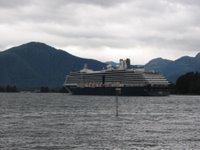 Our next stop, Sitka, was the only port where the monster Oosterdam couldn’t dock. Anchored in the harbor, we were ferried ashore in tenders (i.e., lifeboats), which proved quite an adventure in a power wheelchair.
Our next stop, Sitka, was the only port where the monster Oosterdam couldn’t dock. Anchored in the harbor, we were ferried ashore in tenders (i.e., lifeboats), which proved quite an adventure in a power wheelchair.
Picture me, if you can, attempting to coax a large, unfamiliar conveyance from a huge boat bobbing at one tempo onto a little boat lurching more frenetically, crossing a dancing ramp that was about two inches wider than the chair. My strategy was simple: Close eyes, pray, gun it. I only wish the spectacle had been captured on video for your entertainment.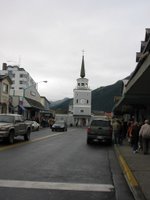
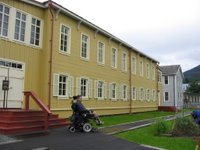
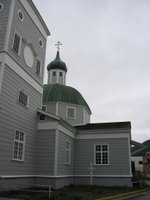
Established by the Russians, Sitka still bears their imprint in the form of some structures and the continued presence of the Orthodox Church. I was intrigued by an old building on the edge of town, which turned out to be a retirement facility called the Pioneer Home. Ain’t that evocative? It didn’t look like a bad place to end up.

 The final stop in Alaska was Ketchikan, best known these days as the proposed site of the infamous Bridge to Nowhere. It was raining so heavily that Dan and I spent less than an hour exploring. The only thing we felt compelled to see was the old red-light district, a motley jumble of wood structures connected by a boardwalk that meandered along and over Ketchikan Creek. It was wonderfully picturesque, but the bordellos have all been replaced by boutiques.
The final stop in Alaska was Ketchikan, best known these days as the proposed site of the infamous Bridge to Nowhere. It was raining so heavily that Dan and I spent less than an hour exploring. The only thing we felt compelled to see was the old red-light district, a motley jumble of wood structures connected by a boardwalk that meandered along and over Ketchikan Creek. It was wonderfully picturesque, but the bordellos have all been replaced by boutiques. If you ever feel overwhelmed by home maintenance, consider this: Wood needs to dry for at least four days before it will hold paint. Four consecutive dry days is so rare in southeastern Alaska, much of which is rain forest, that years can pass before you have the opportunity. Some buildings had more moss than paint.
If you ever feel overwhelmed by home maintenance, consider this: Wood needs to dry for at least four days before it will hold paint. Four consecutive dry days is so rare in southeastern Alaska, much of which is rain forest, that years can pass before you have the opportunity. Some buildings had more moss than paint.
On the last night of the cruise we stopped in Victoria, which we all loved (well, maybe not Ms. I Thought It Would Be Bigger; I didn’t ask her). The capital of British Columbia, Victoria sits at the southern tip of Vancouver Island. The area is in the “rain shadow” of the Olympic Mountains, so it isn’t nearly as damp as most of the Pacific Northwest. After Alaska, it felt like Phoenix to us. (There might be something to that, actually: Victoria is a popular destination for retirees.)
 Most of our group went out to the famed Butchart Gardens, started in 1904 when the wife of a quarry owner found a creative solution for an ugly problem. Eight p.m. isn’t the ideal time to tour a garden, but it was our only chance. There was extensive lighting, and it was an interesting experience. Our bus driver, a native Victorian, narrated brief tours of the handsome downtown on the way to and from Butchart.
Most of our group went out to the famed Butchart Gardens, started in 1904 when the wife of a quarry owner found a creative solution for an ugly problem. Eight p.m. isn’t the ideal time to tour a garden, but it was our only chance. There was extensive lighting, and it was an interesting experience. Our bus driver, a native Victorian, narrated brief tours of the handsome downtown on the way to and from Butchart. We were back in Seattle early the next morning, and before we knew it we were landing at Dulles. As I waited for the plane to empty so they could collect me in the aisle chair, a matronly woman passing by beamed at me and enthused, “You’re a good boy! Very good!” She repeated the assertion to a bemused Dan as she disembarked.
We were back in Seattle early the next morning, and before we knew it we were landing at Dulles. As I waited for the plane to empty so they could collect me in the aisle chair, a matronly woman passing by beamed at me and enthused, “You’re a good boy! Very good!” She repeated the assertion to a bemused Dan as she disembarked.
This “boy” will be 40 in a few months, and as most of you can attest, he is anything but good. However, in a rare moment of self-control, he managed to suppress a powerful urge to squeal, clap his hands in mock delight, and drool.
Good times.
